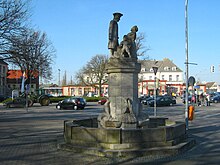Mudder Schulten

Mudder Schulten , also Mother Schulten , Mudder Schultsch is a freely designed literary figure from the late work of the Low German poet Fritz Reuter .
Literary figure
Mudder Schultsch, a particularly resolute baker's wife, first appeared in history as a literary figure when Fritz Reuter erected a literary monument in his humoresque Dörchläuchting in the Mecklenburg Vorderstadt Neubrandenburg as the location of his most creative years. Since then, this figure has been present in various ways in the cultural life of this city with varying intensity.
The name of this character has undergone a colloquial change in the one and a half years of its existence. For Fritz Reuter, who introduces the corpulent, plump baker's wife in the 9th chapter of the humoresque as queen on the Neubrandenburg market square and makes the counterpart of his quirky title hero, she is almost always the Schultsch (Lower German language form of Schultz ). The scandal on Ascension Day on the Neubrandenburg market square when the Schultsch presented her ruler with an unpaid baker's bill from her husband Krischan , whereupon "Dörchläuchten [...] vör anger to the whole Liw [rate], 'Impertinent woman!' rep hei un [...] Ehr de Reknung ut de hand [stödd], dat Krischan Schulten sine sure, siwstünnige written work so light awe the mark, as we don't 'ne blote Schauljung's work " , has since been one of the most famous scenes in Reuter's late work.
Identification attempts
All attempts to identify the baker's wife Schultsch suffer from the same error. Reuter had apparently opened a window of time in the 1780s for his now famous humoresque, on which most attempts at explanation focus. Consequently, one believes to recognize a master baker Jacob (Hinrich) Schultz (1720–1801) in Krischan Schultsch , who had actually had his bakery on the west side of the old Neubrandenburg market square since the middle of the 18th century. As a model for the Mudder Schultsch , his wife Christina Dorothea, b. Zillmann (1727–1802), the daughter of a Neubrandenburg butcher.
However, this traditional interpretation fails to recognize the fact that Reuter, in that humorous style, caricatures states and people at the same time that he himself had come to know and love in Neubrandenburg in the middle of the 19th century. Back then, a good three generations later, at the time of Reuter's presence in this city, the Schultz bakery still existed in the same building on the market and there was still a Mudder Schultsch there (however resolute it might have been).
The only historical documents that can be considered as evidence for the scenery composed by Reuter on the market square are a statement including an accompanying letter from the baker Jacob Schultz for baked goods delivered in the years 1766 and 1767 and not paid for, dated March 12, 1771. This Documents, which Reuter had apparently also got to know, are preserved in the collections of the regional museum in Neubrandenburg .

Mudder Schulten fountain
Reuters fictional characters, Duke Adolf Friedrich IV of Mecklenburg-Strelitz and the baker's wife Schultz, have been permanently present in the cityscape of Neubrandenburg as a group of figures in a sandstone fountain since the 1920s . A long-established fashion store had used its 100th anniversary to present the city with a Döchläuchting fountain created by Wilhelm Jaeger and to have it installed on the market square southwest of the old town hall. On March 31, 1923, the inauguration of the fountain, which the contemporary media soon renamed the Reuter fountain , took place.
The fountain's last name change to date took place in the second half of the 1950s, possibly under political auspices, because the young German Democratic Republic had nothing at all to do with dukes as the leading figures of the old days and with Fritz's legacy Reuter had a hard time at first. What could be more obvious than to rename the fountain again: in 1955 it was still called the Mother Schultzsch Fountain , in 1956 it was suddenly the Mother Schulten Fountain , and soon after the Mudder Schulten Fountain . This name has meanwhile become common.
literature
- Franz Warbehn: News about the Schulz bakery couple from Reuters Dörchläuchting. In: Meckl.-Strel. Homeland papers. Neustrelitz 6 (1930) 2. Pp. 43-45.
- Helmut Borth: The legend of Mudder Schulten. In Ders .: The legend of Mudder Schulten. On the hunt for Mecklenburg history (s). Books on Demand, Norderstedt 2016. ISBN 978-3-7412-5308-9 . Pp. 5-14.
Individual evidence
- ↑ Full text in the Gutenberg.de project
- ↑ Markt 11, house book no. 187.
- ↑ See Franz Warbehn: News about the Schulz bakery couple from Reuters Dörchläuchting. In: Meckl.-Strel. Homeland papers. Neustrelitz 6 (1930) 2. Pp. 43-45.
- ↑ At that time, a courtier had triggered delivery orders from Schultz without authorization, which the state treasury refused to pay.
- ^ Neubrandenburg - construction of the new district town. Ed .: City Council, Neubrandenburg [1955].
- ^ Albert Luckow: Neubrandenburg and its surroundings. Petermänken Verlag, Schwerin 1956. p. 60.